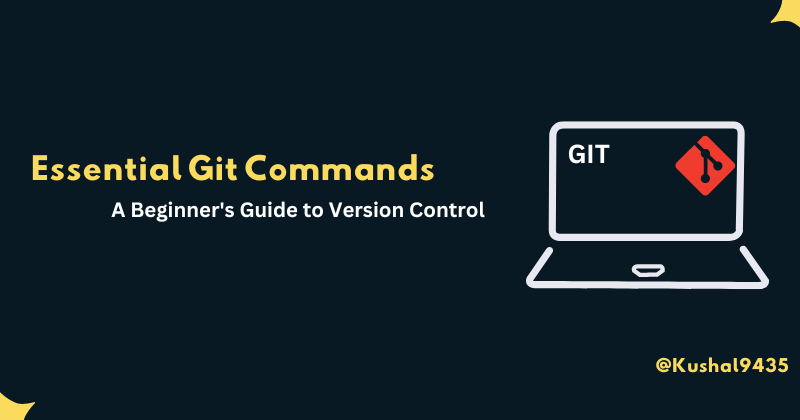Essential Git Commands: A Beginner's Guide to Version Control 🎉
 Kushal Das
Kushal Das
Welcome to your Git introduction! Whether starting a new project or collaborating, mastering Git will help you manage your code efficiently. This guide covers core concepts and essential commands for beginners.
What is Git? 🤔
Git is a distributed version control system designed to help you track changes in your files and collaborate with others seamlessly. Here’s what you can achieve with Git:
Version Control: Keep a history of all changes made to your files, allowing you to revert to previous versions easily. 📜
Collaboration: Work with others on the same project without overwriting each other’s changes. 🤝
Branching and Merging: Develop new features or fixes in isolated branches before integrating them into the main project. 🌱
Getting Started with Git 🚀
1. Initial Configuration ⚙️
Before you start using Git, you need to set up some basic configurations:
Configure Your Identity
Establish your name and email address to properly attribute your changes:
git config --global user.name "Your Name"
git config --global user.email "your-email@example.com"
Set the Default Branch Name
Choose a default name for your primary branch (commonly "main" or "master"):
git config --global init.defaultBranch main
Additional Configurations
Default Pull Behavior: Make rebase the default strategy when pulling changes.
git config --global pull.rebase trueAuto-Stash on Rebase: Automatically save your changes when rebasing.
git config --global rebase.autoStash truePush Current Branch by Default: Ensure that
git pushsends the current branch to the remote repository.git config --global push.default current
2. Essential Git Commands 💻
Here are the fundamental commands you’ll need to navigate and manage your projects effectively:
Cloning a Repository
To create a local copy of a remote repository, use:
git clone <repository-url>
Check Repository Status
Monitor the state of your working directory:
git status
Stage Changes
Before committing, stage your changes:
git add <file-name>
To stage all changes:
git add .
Commit Changes
Save your staged changes with a clear and meaningful message:
git commit -m "Your descriptive commit message"
View Commit History
Examine your commit history to see what changes have been made:
git log
For a simplified view:
git log --oneline
Push Changes to Remote
To upload your committed changes to the remote repository:
git push
Pull Changes from Remote
Retrieve the latest changes from the remote repository and merge them into your current branch:
git pull
3. Branching and Merging 🌿
Branches are crucial for working on features or fixes independently. Here’s how to manage them:
Create a New Branch
Start a new branch for your work:
git switch -c <branch-name>
To create a branch without switching to it:
git branch <branch-name>
Switch Between Branches
Change to another branch easily:
git switch <branch-name>
List All Branches
See all branches in your repository:
git branch
Merge a Branch
Combine changes from one branch into your current branch:
git merge <branch-name>
Delete a Branch
Remove a branch that is no longer needed:
Locally:
git branch -d <branch-name>Remotely:
git push origin --delete <branch-name>
4. Stashing Changes 💾
Stashing allows you to save your current changes temporarily without committing them.
Save Changes to a Stash
Store your changes for later:
git stash
Apply Stash
Retrieve your stashed changes when needed:
git stash apply
List Stashed Changes
View your stashed entries:
git stash list
5. Viewing Differences and Undoing Changes 🔍
Viewing Differences
To see what changes have been made since your last commit:
git diff
To see changes that are staged for the next commit:
git diff --cached
Undoing Changes
To unstage a file that has been added to the staging area:
git reset <file-name>
To discard changes in your working directory:
git checkout -- <file-name>
Conclusion 🎊
This guide offers the essential Git commands and concepts to kickstart your coding journey. With Git, you can collaborate, manage changes, and keep your projects organized. Dive in and enjoy coding with version control! 🚀
Thanks for reading all the way to the end! 💖
If you have any questions, please use the comments section 💬
Let's connect! Find me on the web 🔗
If you have any Queries or Suggestions, feel free to reach out to me.
Happy Coding :)❤️
Subscribe to my newsletter
Read articles from Kushal Das directly inside your inbox. Subscribe to the newsletter, and don't miss out.
Written by

Kushal Das
Kushal Das
A Full Stack Web Developer | A Mentor | A freelancer💻 | Data science enthusiastic | Open source enthusiastic | Create and write content | Enjoy learning new techs | love meeting new people! 😊

